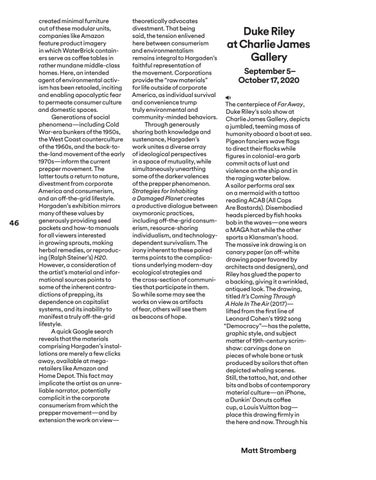46
created minimal furniture out of these modular units, companies like Amazon feature product imagery in which WaterBrick containers serve as coffee tables in rather mundane middle-class homes. Here, an intended agent of environmental activism has been retooled, inciting and enabling apocalyptic fear to permeate consumer culture and domestic spaces. Generations of social phenomena—including Cold War-era bunkers of the 1950s, the West Coast counterculture of the 1960s, and the back-tothe-land movement of the early 1970s—inform the current prepper movement. The latter touts a return to nature, divestment from corporate America and consumerism, and an off-the-grid lifestyle. Hargaden’s exhibition mirrors many of these values by generously providing seed packets and how-to manuals for all viewers interested in growing sprouts, making herbal remedies, or reproducing (Ralph Steiner’s) H20. However, a consideration of the artist’s material and informational sources points to some of the inherent contradictions of prepping, its dependence on capitalist systems, and its inability to manifest a truly off-the-grid lifestyle. A quick Google search reveals that the materials comprising Hargaden’s installations are merely a few clicks away, available at mega- retailers like Amazon and Home Depot. This fact may implicate the artist as an unreliable narrator, potentially complicit in the corporate consumerism from which the prepper movement—and by extension the work on view—
theoretically advocates divestment. That being said, the tension enlivened here between consumerism and environmentalism remains integral to Hargaden’s faithful representation of the movement. Corporations provide the “raw materials” for life outside of corporate America, as individual survival and convenience trump truly environmental and community-minded behaviors. Through generously sharing both knowledge and sustenance, Hargaden’s work unites a diverse array of ideological perspectives in a space of mutuality, while simultaneously unearthing some of the darker valences of the prepper phenomenon. Strategies for Inhabiting a Damaged Planet creates a productive dialogue between oxymoronic practices, including off-the-grid consumerism, resource-sharing individualism, and technology- dependent survivalism. The irony inherent to these paired terms points to the complications underlying modern-day ecological strategies and the cross-section of communities that participate in them. So while some may see the works on view as artifacts of fear, others will see them as beacons of hope.
Duke Riley at Charlie James Gallery September 5– October 17, 2020 The centerpiece of Far Away, Duke Riley’s solo show at Charlie James Gallery, depicts a jumbled, teeming mass of humanity aboard a boat at sea. Pigeon fanciers wave flags to direct their flocks while figures in colonial-era garb commit acts of lust and violence on the ship and in the raging water below. A sailor performs oral sex on a mermaid with a tattoo reading ACAB (All Cops Are Bastards). Disembodied heads pierced by fish hooks bob in the waves—one wears a MAGA hat while the other sports a Klansman’s hood. The massive ink drawing is on canary paper (an off-white drawing paper favored by architects and designers), and Riley has glued the paper to a backing, giving it a wrinkled, antiqued look. The drawing, titled It’s Coming Through A Hole In The Air (2017)— lifted from the first line of Leonard Cohen’s 1992 song “Democracy”—has the palette, graphic style, and subject matter of 19th-century scrimshaw: carvings done on pieces of whale bone or tusk produced by sailors that often depicted whaling scenes. Still, the tattoo, hat, and other bits and bobs of contemporary material culture—an iPhone, a Dunkin’ Donuts coffee cup, a Louis Vuitton bag— place this drawing firmly in the here and now. Through his
Matt Stromberg
